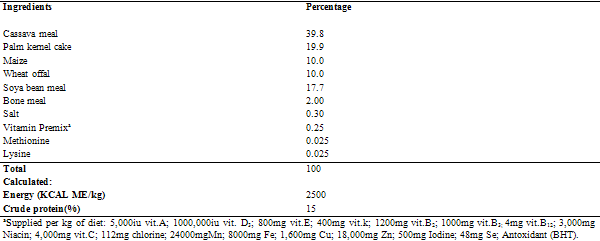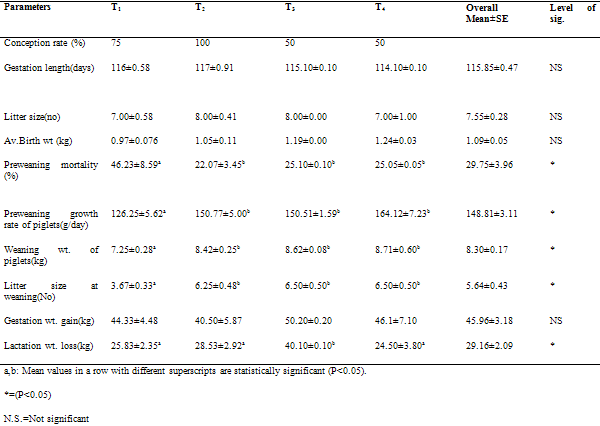Effect of Combination of Dietary Alpha-Tocopherol and Ascorbic Acid on the Reproductive Performance of Gilts
An experiment was conducted at the piggery unit of the Department of Animal Science Farm, University of Nigeria, to evaluate the effect of dietary combination of alpha-tocopherol and ascorbic acid on the reproductive performance of gilts in the humid tropical zone of Nigeria.
Sixteen(16) twenty weeks old gilts were selected for this trial. The gilts were randomly assigned to four dietary treatments. Each treatment was replicated twice with two gilts per replicate making up four gilts per treatment.
One experimental ration containing 15% CP and 2,500Kcal/kgME was used but different levels of vitamins E and C for each treatment were added to the feed at the time of feeding. The gilts were placed on the gestation/lactation diet immediately after selection and were allowed to attain their second estrus before mating took place. The body weights of the gilts were recorded before mating following the manifestation of second estrus and date of mating recorded. Gilts were fed 2.0kg of the 15% CP diet each day when pregnancy was confirmed. Weekly body weights of the gilts were subsequently taken throughout the gestation period. At farrowing, their ration was increased to 2.6kg per pig per day until piglets were weaned at the age of 8 weeks. The birth weights of the piglets were recorded within 24 hours of parturition and subsequently, piglets’ weekly body weights were recorded until weaning. Similarly, the body weights of the lactating sows were taken weekly to monitor their body weight changes during lactation. All the data were processed and analyzed in accordance with 2x2 factorial arrangements in a completely randomized design (CRD). The result of the experiment showed that average litter size values of 7.00±0.58, 8.00±0.41, 8.00±0.00 and 7.00±1.00 for T1, T2, T3 andT4, respectively and the corresponding birth weight mean values of 0.97±0.08kg, 1.05±0.11kg, 1.19±0.00kg and 1.24±0.03kg were not significantly different (P>0.05) among the treatments. Significantly lower (P<0.05) pre-weaning body weight gain (g/day/piglet) was observed for piglets on T1 with mean value of 126.25±5.62 compared to piglets on T2, T3 and T4 with respective values of 150.77±5.00, 150.51±1.59 and 164.12±7.23. A range of 22.07±3.45% to 25.10±0.10% pre-weaning mortality was observed across treatments. Piglets on T1 had the least weaning weight of 7.25±0.28kg which differed significantly (P<0.05) from piglets on T2, T3 and T4 with weaning weight values of 8.42±0.24kg, 8.62±0.08kg and 8.71±0.60kg, respectively. The highest (P<0.05) gestation weight gain of 44.33±4.48kg was observed in gilts on T1.
This study finally suggested that dietary supplementation with vitamins E and C at 250 mg vitamin C alone, 120 IU vitamin E alone and 120 IU vitamin E/250 mg vitamin C combination during gestation of gilts and their lactation will effectively enhance litter size and lactation performance.
Key words: alpha-tocopherol, ascorbic acid, reproduction, gilts.



Adebambo, O.A (1986) Genetic and environmental effect on litter productivity of exotic and indigenous pure and crossbred pigs in Nigeria. Bull Anim. Hlth prod. Afr. 34: 75-80
Ashworth, C.J. (1994) Nutritional factors related to embryonic mortality in Domestic species. In: M.T. Zavy and R.D. Geisert (eds). Embryonic mortality in domestic species, CRC Press. London Pp: 179-194.
Belstra, B.A. (2003) Parity associated with changes in reproductive performance: Physiological basis or record keeping artifact? Paper presented at the Ann. Meeting of the AASV, March 8-11, 2003, Kissimmee, FL, Seminar N7, Live Gilt. Free. North Carolin State University.
Blasco, A., J.P. Bidavel and C. Haley (1995) Genetics and neonatal survival , pp 17-38 In: The Neonatal Pig. Development and Survival. Edited by M.A. Varley, CAB International, Wallingford Oxon, UK.
Booth, P.J. (1990) Metabolic influences in hypothalamic- pituitary-ovarian function in the pig. J. Reprod. Fertl. (Suppl)40: 89-100.
Dagorn, J., B. Badouard and Boulot, S (1998) Pork performances. ITP, France.
Davidson, H.R and W.E Coey (1966) The Production and Marketing of Pigs, 3rd ed. P 39
Davidson, H.R. (1948) The production and marketing of pigs. Longman: London.
Day, B.N. (1972) Reproduction of swine. In: Reproduction in Farm Animals. E.S.E. Hafez (ed) 2nd edn. Lea and Fabiger, pp 279-288.
Edwards, R.L., I.T. Omtvedt., E.J. Tuman., D.F. Stephens and Mahoney, G.W.A. (1968) Reproductive performance of gilts following heat stress prior to breeding and in early gestation. J. Anim.Sci. 27: 1634-7.
Ehiobu, N.G., J.A. Ayoade and Njike, M.C. (2000) Productivity of Large white, Hampshire breeds and their crosses at NAPRI swine herd, Otukpo, Benue state. J. Agric. Tech and Educ. Vol. 5: 21-27.
Gey, K.F.(1998).Vitamins E and C and interacting co-nutrients required for optimum health. Biofactors, 7: 113-174
Gino, Totte. Panagro. (2008). The Vitamin C Question: J. Health and Nutrition. !5: 35- 37.
Heap, R.B., J.S. Perry and J.R.G. Challis (1973) Hormonal maintenance of pregnancy. In: Handbook of physiology vol.2; 217-259. R.O. Green and E.B. Astwood eds. American Physiological Association.
Herbert, U. (1998) Reproductive performance of rabbit does fed diets containing gliricida leaf from conception through weaning of kits. Nig. J. Anim.Prod. 25: 163-168.
Ji, F., G. Wu., J.R. Blanton Jr and S.W. Kim (2005) Changes in weight and composition in various tissues of pregnant gilt and their nutritional implications. J.Anim.Sci. 83: 336-375.
Mahan, D.C, (1991) Assessment of the influence of dietary vitamin E on sows and offspring in 3 parities: Rep. performance, tissue tocopherol and effect on progeny, J. Anim. Sci. 69: 2904.
Mahan, D.C.(1994) Effect of dietary vitamin E on sow reproducetion. J. Anim Sci. vol.72, 11: 2870-2879.
Mavromichalis, I. (2010) The Impact of preweaning mortality on litter size of pigs: Article, Nov., 2010
Mcdowell, L.R.(1989).Vitamins in animal nutrition, In: Mcdowell L.R (ed). Comparative aspect of human nutrition, vit.C, folacin(London Aed. Press) Pp 365-387.
Noblet, J. and J. Le Dividchi (1981) Energy metabolism in the newborn pig during the first 24hr of life. Biology of the neonate. 40: 175-182.
Nwangwu, A.C. (2012) Effect of dietary supplementation with vitamins E and C on the productive performance of pigs. Ph.D Thesis, University of Nigeria, Nsukka, 2012.
Omtveldt, I.T., R.E. Nelso., R.L. Edwards., D.S. Stephen and Turman, E.J. (1971) Influence of heat stress during early, mid and late pregnancy of gilts. J. Anim. Sci. 32: 312-17.
Oseni, S. (2005) Evaluation of the F1 and backcrosses of Nigerian local pigs and the Large White for litter characteristics in South-West, Nigeria. Livestock Research for Rural Development, 17(4) 2005.
Reese, D.E., J.E.R. Peo and A.J. Lewis (1984) Relationship of lactation energy intake and occurrence of post-weaning estrus to body and back fat composition in sows. J. Anim.Sci. 58: 1236-1244.
Rekwot, P.I., J.O. Jegede., O.W. Ehiche and Tegbe, T.S.B. (2001) Reproductive performance in small holder piggeries in Northern Nigeria. Tropical Agriculture 78(2): 130-133.
Revell, D.K., I.A. Williama., B.P. Mullan., J.L. Ranrod and Smiths, R.J. (1998) Body composition at farrowing and nutrition during lactation affect the performance of primiparous sows: I Vountary feed intake, weight loss and plasma metabolism. J. Anim. Sci 76: 1720-1737.
Robinson, J.J. (1990) Nutrition in the reproduction of farm animals. Nutrition Research Reviews 3: 253-276.
Rothschild, M.F. and J.P.Bidavel (1998) Biology and genetics of reproduction. In the genetics of the pig. Edited by M.F. Rothschild and A.Ruvinsky. CAB International, Wallingford, Oxon, UK. Pp 313-343.
Solymosi, F. and P. Hom (1994) Protein content and amino acid composition of the uterine milk in swine and cattle. ACTA Veterinaria Hungarica 42: 487-497
Sorensen,D., A. Vernersen and S.Andersen (2002) Bayesian analysis of response to selection, a case study using litter size in Danish Yorkshire pigs. Genetics 156: 283-285.
Specht, T.A., D.C, Mahan., N.D, Fastinger and R.L, Stuart (2003). Effect of d-α- tocopherol alcohol or acetate in water soluble or emulsified form in the drinking water of weanling pigs. J Anim. Sci 81(suppl.2): 88 (abst. 356).
Trottier, N.L. and L.N. Johnson (2001) Feeding gilts during development and sows during gestation and lactation. In: Swine nutrition 2nd ed. A .J. Lewis and Southern L.L. ed., CRC press, NewYork. Pp725-769.
Verstegen, M.W.A., W.H. Close.,I.B. Start and L.F. Mount (1973) The effect of environmental temperature and plane of nutrition on heat loss, energy retention and deposition of protein and fats in groups of growing pigs. Brit. J. Nutr., 30: 21-35.
Williamson, G. and W.J.A. Payne (1978) Introduction to Animal Husbandry in the Tropics, 3rd Ed. P 544-548
Yen, J.T. and W.G. Pond(1981) Effects of dietary vitamin C addition on performance, plasma Vitamin C and hematic iron status in weanling.Pigs: J. Anim. Sci: 53: 1292.








